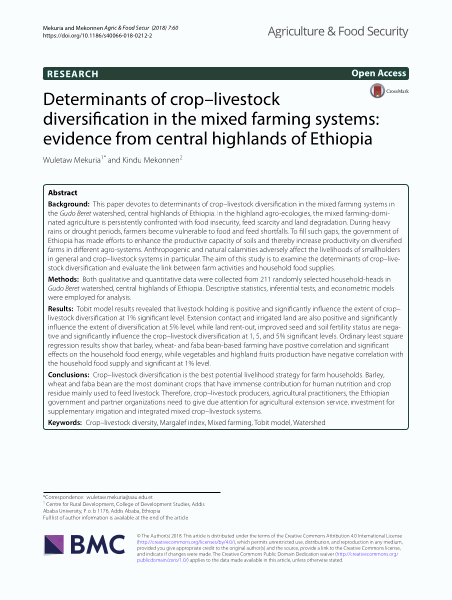Determinants of crop–livestock diversification in the mixed farming systems: Evidence from central highlands of Ethiopia
Abstract
Background This paper devotes to determinants of crop–livestock diversification in the mixed farming systems in the Gudo Beret watershed, central highlands of Ethiopia. In the highland agro-ecologies, the mixed farming-dominated agriculture is persistently confronted with food insecurity, feed scarcity and land degradation. During heavy rains or drought periods, farmers become vulnerable to food and feed shortfalls. To fill such gaps, the government of Ethiopia has made efforts to enhance the productive capacity of soils and thereby increase productivity on diversified farms in different agro-systems. Anthropogenic and natural calamities adversely affect the livelihoods of smallholders in general and crop–livestock systems in particular. The aim of this study is to examine the determinants of crop–livestock diversification and evaluate the link between farm activities and household food supplies. Methods Both qualitative and quantitative data were collected from 211 randomly selected household-heads in Gudo Beret watershed, central highlands of Ethiopia. Descriptive statistics, inferential tests, and econometric models were employed for analysis. Results Tobit model results revealed that livestock holding is positive and significantly influence the extent of crop–livestock diversification at 1% significant level. Extension contact and irrigated land are also positive and significantly influence the extent of diversification at 5% level, while land rent-out, improved seed and soil fertility status are negative and significantly influence the crop–livestock diversification at 1, 5, and 5% significant levels. Ordinary least square regression results show that barley, wheat- and faba bean-based farming have positive correlation and significant effects on the household food energy, while vegetables and highland fruits production have negative correlation with the household food supply and significant at 1% level. Conclusions Crop–livestock diversification is the best potential livelihood strategy for farm households. Barley, wheat and faba bean are the most dominant crops that have immense contribution for human nutrition and crop residue mainly used to feed livestock. Therefore, crop–livestock producers, agricultural practitioners, the Ethiopian government and partner organizations need to give due attention for agricultural extension service, investment for supplementary irrigation and integrated mixed crop–livestock systems.

